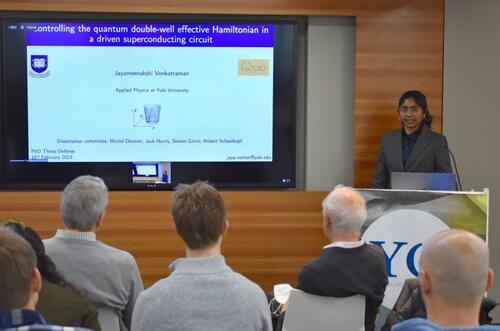
On February 16, 2023, Jaya Venkatraman successfully defended the thesis, “Controlling the effective Hamiltonian of a driven quantum superconducting circuit” (advisor: Michel Devoret).
Venkatraman explained, “In a quantum world, there is always a path to escape from a trap — thanks to the quantum tunnel effect. Counter-intuitively, if another path is also available, the escape paths can be arranged so that they coherently destroy each other and completely block the way out — thanks to the quantum interference effect. When tunneling across the classically forbidden region is coherently canceled for the ground state, the only path to escape is to climb the walls of the trap and tunnel through the excited states. This is, unless quantum effects also destroy the escape ways through the excited states… In this work, we experimentally demonstrate this multi-level blocking — the vanishing of quantum tunneling in the ground and excited states of a quantum-double well which represents the effective quantum dynamics of our system: a driven nonlinear oscillator. Our quantum double-well is implemented in a microwave-driven Josephson superconducting circuit. Underlying this experiment is a novel theoretical tool to compute the effective Hamiltonians of driven nonlinear oscillators.”
Venkatraman will next be working as a postdoctoral researcher at the University of California, Santa Barbara.
Thesis abstract:
Can we observe and control the quantum manifestations of an effective Hamiltonian in a superconducting circuit submitted to a fast-oscillating driving force?
We have implemented the effective Hamiltonian of a Kerr oscillator submitted to a squeezing drive in a Josephson tunnel junction-based quantum superconducting circuit submitted to a microwave sinusoidal driving excitation. We experimentally measure multiple simultaneous degeneracies in the spectrum of this effective Hamiltonian, which models a quantum double well. What underlies these simultaneous degeneracies is the unusual destructive interference of tunnel paths in the classically forbidden region, an effect revealing a hidden symmetry of the system. Not only can these degeneracies be turned on-and-off on demand, but their number is tunable: when the detuning of the drive’s second subharmonic from the oscillator frequency Δ equals an even multiple of the Kerr coefficient K, Δ/K = 2m, the oscillator experiences m+1 exact spectral degeneracies. Importantly, these degeneracies are robust as they are completely independent of the drive amplitude. They also lead to a drastic reduction of the incoherent well-switching rate leading to our realization of a super-protected cat qubit. Our work indicates the circumstances by which the control of parametric processes via the drive frequency can provide a practical new tool for quantum technologies. Underlying this experiment is a calculation tool to transform—beyond the rotating-wave approximation—a time-dependent Hamiltonian describing a superconducting nonlinear circuit submitted to a fast-oscillating driving force to a time-independent effective Hamiltonian governing the dynamics of our quantum double-well system.